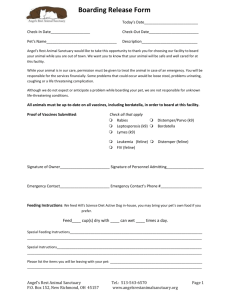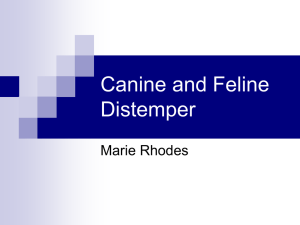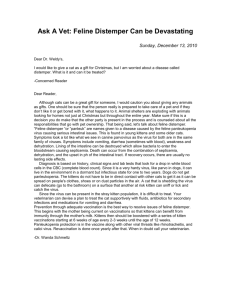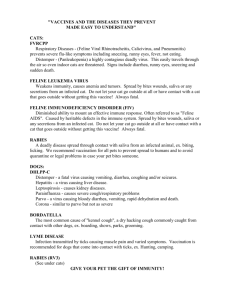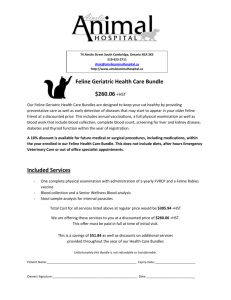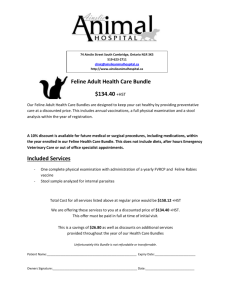Kitsap Humane Society – Foster Care Program
advertisement
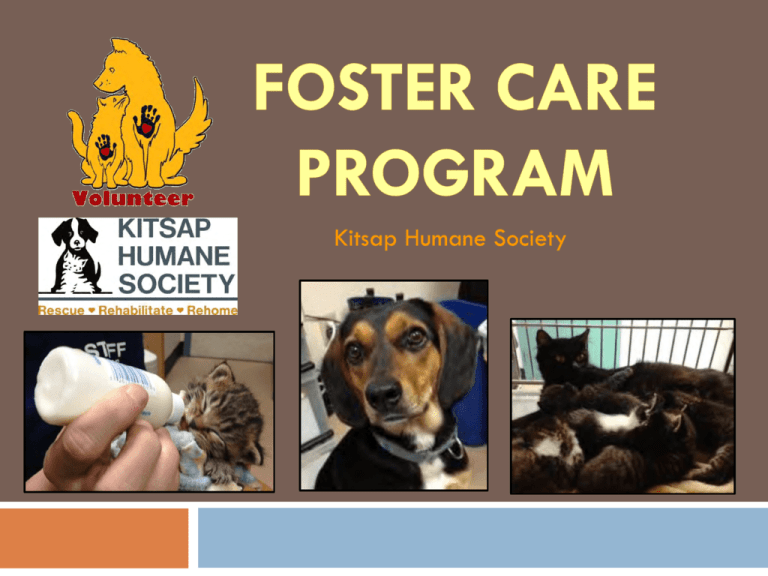
Keep Your Pets Safe PLEASE KEEP ME HEALTHY & SAFE Separate foster animals from pets for at least 2 weeks, preferably in a non-carpeted area to prevent disease Introduce pets to foster animals in a controlled, supervised environment Watch for warning signs of stress to avoid conflict Body language (see articles listed on KHS Foster Webpage) Prevent Spreading Disease Isolate sick animals immediately Avoid indirect contact between animals (bowls, toys, play areas, etc) Move back into animal housing area if no signs of disease 7 – 10 days after cleared of illness Sanitation Wash hands between handling fosters and pets Change clothes between handling ill or high-risk fosters and pets for at least 2 weeks (wear a smock or designated jacket) Use 1:32 bleach to water ratio to sanitize all surfaces and laundry after fostering, every time Health It is important to log and finish all medications, and note the day that symptoms subside. Ways Diseases Are Spread Objects (“fomites”) Direct contact with sick animal/disease particle (ex: Ringworm spores) Air Feces Urine Saliva Vomit & other bodily substances Insects & rodents (“vectors”) Common Types of Pathogens Viruses Bacteria Fungi Parasites What is an “Incubation Period”? Period of time between getting the disease and showing symptoms Disease cannot be detected by tests yet Example: PARVO What is a “Carrier”? An animal who appears healthy, but who is actually harboring a disease May be shedding the disease undetected Makes other animals sick Can be a lifelong condition (Feline Calici, Herpes) Does Stress Matter? Stress is a leading contributing factor to animal disease Lowers disease resistance Physical, emotional & environmental Can be caused by change in diet, routine or environment Signs of stress are same as signs of disease: vomiting, loss of appetite, self mutilation, diarrhea, depression & aggression Foster care reduces stress and so animals recover more quickly Stressors in Animal Facilities Physical Malnourished Pregnant/lactating Injured Parasite –laden Diseased Emotional Fear Pain Anxiety Boredom Depression Environmental: Too hot, cold Too humid Too wet Poor ventilation Noise, overcrowding Identifying a Sick Animal EYES Watery or too dry Red or discolored Swollen or itchy Middle eyelid shows Discharge Squinting Unequal pupil sizes Filmy or cloudy EARS Discharge Crusty Swollen or Red Matted Hair Scabby Fly-bitten Itchy (animal scratches ear or shakes head) Painful (animal cries when ear is touched) Identifying a Sick Animal, Continued NOSE Discharge (clear, mucus, blood or pus) Crusty Cracked Skin Scabby Congested or blocked BREATHING Irregular, rapid, shallow or having trouble breathing at all Sneezing, coughing, Wheezing “Rattling” chest Unable to breath through nose Normal rate at rest is 1626 breaths/minute Identifying a Sick Animal, Continued GENERAL APPEARANCE Overly fat or thin Wounds, lumps or sores Swollen or discharging teats Dehydration (how to tell) Head tilting Bloated stomach Lethargy NOSE Above 102.8 F Anal Below 100.2 F Anal Dog Diseases “Kennel Cough” CONTAGIOUS True KC caused by a bacteria (Bordatella), which we vaccinate against Similar Upper Respiratory Infections (URI) caused by a Mycoplasma and/or viruses including Parainfluenza (P) and Adenovirus type-2 Symptoms of common cold, normally goes away on its own in 5-10 days Can develop into bronchopneumonia in young, ill, stressed dogs “Kennel Cough”, Continued Incubation period 3 to 10 days Lives in environment for days up to 3 weeks Spread through air, direct contact with nasal secretions, and fomites Distemper and infectious hepatitis can produce symptoms of URI Distemper Highly contagious and often fatal Caused by a virus Begins as URI, followed by intestinal, then damages nervous system High fever Lack of appetite Lethargy Watery eye discharge Dry Cough Hard foot pads Seizures, rhythmic jerks twitches Pain, crying Distemper, Continued Vaccinated dogs may only show neurological signs – they skip the URI phase Puppies highly susceptible Incubation period: 9 – 14 days Lives in environment 9-14 days Can cause long term health problems, such as paralysis, nervous, or sensory disorders Spread by fomites, direct contact with nasal secretions, and air Parvovirus Highly contagious and often fatal Viral intestinal disease Affects dogs of any age, but puppies are more frequently and severely affected Bloody diarrhea, vomiting, lethargy, may also attack the heart in pups under 3 months old causing sudden cardiac failure Parvovirus, Continued Incubation period: 4 -10 days Lives in environment for long period of time; must use bleach to sanitize after Parvo Parvo test only accurate 3-4 days after infection; once symptoms are evident Spread by fomites or feces Cat Diseases Upper Respiratory Infection (URI) Highly contagious, spread by air, fomites, and contact Stress and overcrowding contribute to outbreaks Persians and kittens are predisposed 90% of URI cases are caused by one of two viruses or both: Rhinotracheitis causes Feline Herpes Calicivirus URI, Continued May also be caused by a bacteria Chlamydia Symptoms of common cold, normally goes away on its own in 10 -21 days, but can develop into bronchopneumonia in young, ill, stressed cats My also cause lameness and gastrointestinal disorder URI infections are permanent and Herpes reoccurs URI, Continued Vaccines available, but new “strains” Incubation period 2 – 6 days Lives in environment 18 – 48 hours, but Calici endures for 10 days Cats can shed Calici virus for life Feline Herpes is shed for 2 weeks post-stressful event, and may cause severe eye damage Feline Herpes (Rhinotracheitis) Diseases Affecting Dogs & Cats Identifying Worms See them in stool (roundworms) Diarrhea, weight loss, anemia, weakness Fecal sample (hookworms, etc. but not 100% reliable) Tapeworm signs and sources (rodents, fleas) Tracing Internal Parasites Wormers must be repeated Worm eggs may be hard to kill Most puppies and kittens have worms Types of wormers Wormers that kill many kinds of worms are called “broad spectrum” For example: KHS worms upon intake Whipworms, tapeworms, Coccidia & Giardia need special wormers How Diseases Spread FECES Parvo & Corona Canine Viral Hepatitis Feline Panleukopenia Upper Respiratory Viruses Feline Infectious Peritonitis (FIP) Salmonella Toxoplasma Worms (rounds, whips, hooks) Giardia and Coccidia Canine Distemper AIR URI (cats) Kennel Cough (dogs) Canine Distemper How Diseases Spread CONTACT Ringworm Sarcoptic Mange Ear mites Feline URI FIP INSECT ‘VECTORS” Mosquitoes spread heartworm Fleas spread tapeworms and Feline Panleukopenia Deer ticks spread Lyme Disease How Diseases Spread INFECTED OBJECTS (FOMITES) Ringworm spread on shirt/bedding Feline URI, Panleukopenia, FIP Parvo, Canine Distemper, Corona, Leptospirosis, Hepatitis Cage walls, toys, bedding, shoes, dogs’ hair/feet etc. YOUR HANDS One of the most significant way diseases are spread WASH YOUR HANDS!! Examples of Fomites Hands, clothing, boots, gloves Cleaning utensils Food & Water dishes, litter boxes Toys, ropes, leashes, muzzles Medical equipment Plastic cage card holders Holding and transport cages Pens & Pencils Medical Emergencies If during open hours, bring foster animal into the shelter immediately If after hours, call the emergency number listed on the Foster Request Form Information This slideshow is meant as a supplement to the Foster Program Manual, please read and study both There are articles listed on the KHS Foster Care Webpage for more information on socialization, behavior, bottle feeding, etc E-mail foster@kitsap-humane.org with any questions THANK YOU!! WE CAN’T DO IT WITHOUT YOU!!
